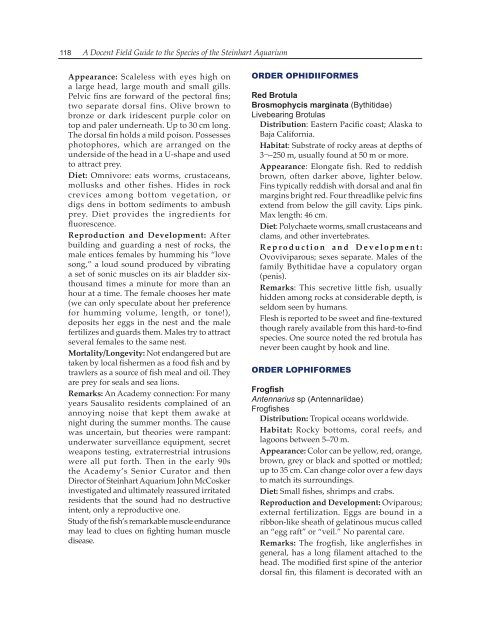THE STEINHART AQUARIUM - Gulf of Guinea Science ...
THE STEINHART AQUARIUM - Gulf of Guinea Science ...
THE STEINHART AQUARIUM - Gulf of Guinea Science ...
Create successful ePaper yourself
Turn your PDF publications into a flip-book with our unique Google optimized e-Paper software.
118 A Docent Field Guide to the Species <strong>of</strong> the Steinhart Aquarium<br />
Appearance: Scaleless with eyes high on<br />
a large head, large mouth and small gills.<br />
Pelvic fins are forward <strong>of</strong> the pectoral fins;<br />
two separate dorsal fins. Olive brown to<br />
bronze or dark iridescent purple color on<br />
top and paler underneath. Up to 30 cm long.<br />
The dorsal fin holds a mild poison. Possesses<br />
photophores, which are arranged on the<br />
underside <strong>of</strong> the head in a U-shape and used<br />
to attract prey.<br />
Diet: Omnivore: eats worms, crustaceans,<br />
mollusks and other fishes. Hides in rock<br />
crevices among bottom vegetation, or<br />
digs dens in bottom sediments to ambush<br />
prey. Diet provides the ingredients for<br />
fluorescence.<br />
Reproduction and Development: After<br />
building and guarding a nest <strong>of</strong> rocks, the<br />
male entices females by humming his “love<br />
song,” a loud sound produced by vibrating<br />
a set <strong>of</strong> sonic muscles on its air bladder sixthousand<br />
times a minute for more than an<br />
hour at a time. The female chooses her mate<br />
(we can only speculate about her preference<br />
for humming volume, length, or tone!),<br />
deposits her eggs in the nest and the male<br />
fertilizes and guards them. Males try to attract<br />
several females to the same nest.<br />
Mortality/Longevity: Not endangered but are<br />
taken by local fishermen as a food fish and by<br />
trawlers as a source <strong>of</strong> fish meal and oil. They<br />
are prey for seals and sea lions.<br />
Remarks: An Academy connection: For many<br />
years Sausalito residents complained <strong>of</strong> an<br />
annoying noise that kept them awake at<br />
night during the summer months. The cause<br />
was uncertain, but theories were rampant:<br />
underwater surveillance equipment, secret<br />
weapons testing, extraterrestrial intrusions<br />
were all put forth. Then in the early 90s<br />
the Academy’s Senior Curator and then<br />
Director <strong>of</strong> Steinhart Aquarium John McCosker<br />
investigated and ultimately reassured irritated<br />
residents that the sound had no destructive<br />
intent, only a reproductive one.<br />
Study <strong>of</strong> the fish’s remarkable muscle endurance<br />
may lead to clues on fighting human muscle<br />
disease.<br />
ORDER OPHIDIIFORMES<br />
Red Brotula<br />
Brosmophycis marginata (Bythitidae)<br />
Livebearing Brotulas<br />
Distribution: Eastern Pacific coast; Alaska to<br />
Baja California.<br />
Habitat: Substrate <strong>of</strong> rocky areas at depths <strong>of</strong><br />
3¬–250 m, usually found at 50 m or more.<br />
Appearance: Elongate fish. Red to reddish<br />
brown, <strong>of</strong>ten darker above, lighter below.<br />
Fins typically reddish with dorsal and anal fin<br />
margins bright red. Four threadlike pelvic fins<br />
extend from below the gill cavity. Lips pink.<br />
Max length: 46 cm.<br />
Diet: Polychaete worms, small crustaceans and<br />
clams, and other invertebrates.<br />
R e p r o d u c t i o n a n d D e v e l o p m e n t :<br />
Ovoviviparous; sexes separate. Males <strong>of</strong> the<br />
family Bythitidae have a copulatory organ<br />
(penis).<br />
Remarks: This secretive little fish, usually<br />
hidden among rocks at considerable depth, is<br />
seldom seen by humans.<br />
Flesh is reported to be sweet and fine-textured<br />
though rarely available from this hard-to-find<br />
species. One source noted the red brotula has<br />
never been caught by hook and line.<br />
ORDER LOPHIFORMES<br />
Frogfish<br />
Antennarius sp (Antennariidae)<br />
Frogfishes<br />
Distribution: Tropical oceans worldwide.<br />
Habitat: Rocky bottoms, coral reefs, and<br />
lagoons between 5–70 m.<br />
Appearance: Color can be yellow, red, orange,<br />
brown, grey or black and spotted or mottled;<br />
up to 35 cm. Can change color over a few days<br />
to match its surroundings.<br />
Diet: Small fishes, shrimps and crabs.<br />
Reproduction and Development: Oviparous;<br />
external fertilization. Eggs are bound in a<br />
ribbon-like sheath <strong>of</strong> gelatinous mucus called<br />
an “egg raft” or “veil.” No parental care.<br />
Remarks: The frogfish, like anglerfishes in<br />
general, has a long filament attached to the<br />
head. The modified first spine <strong>of</strong> the anterior<br />
dorsal fin, this filament is decorated with an


